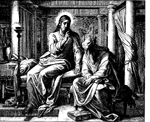His name is John, but...
John was born in a small town. When he was a young man, he joined a relatively new and controversial religious order. He was sent to Paris for his studies and eventually obtained a teaching position there.
Several years later, serious accusations were lodged against his religious order and he was forced to stop teaching. Shortly after that, at the age of 36, he was elected head of the order. He wrote extensively, defended the order against its detractors, dealt with serious divisions within the order, and made important structural improvements. After about ten years, the Pope vindicated John’s order and formally condemned its greatest critic. The University bestowed on him a doctoral degree. The Pope would eventually force upon him the offices of Bishop and Cardinal.
John became widely known for his theological wisdom and personal holiness (there were many stories of miracles). He went on to have a great influence on the Universal Church: advising Popes and acting as the guiding force of an Ecumenical Council. Suddenly, while the Council was still in session, John died, still in his early 50’s. He may have been poisoned by his enemies, but they could not conquer him: his order, the Franciscans, would continue; and his theological writings would be venerated as among the best of all time.
Early in his life, John stopped being known by his baptismal name. There were many different stories about where he got the new name. One story says that when John was a little child, his parents had brought him to St. Francis not long before his death and that St. Francis himself was the origin of John’s new name: Bonaventure.
Bonaventure was recognized as a saint with little delay. In due course, he was listed as a “Doctor of the Church.”
Several years later, serious accusations were lodged against his religious order and he was forced to stop teaching. Shortly after that, at the age of 36, he was elected head of the order. He wrote extensively, defended the order against its detractors, dealt with serious divisions within the order, and made important structural improvements. After about ten years, the Pope vindicated John’s order and formally condemned its greatest critic. The University bestowed on him a doctoral degree. The Pope would eventually force upon him the offices of Bishop and Cardinal.
John became widely known for his theological wisdom and personal holiness (there were many stories of miracles). He went on to have a great influence on the Universal Church: advising Popes and acting as the guiding force of an Ecumenical Council. Suddenly, while the Council was still in session, John died, still in his early 50’s. He may have been poisoned by his enemies, but they could not conquer him: his order, the Franciscans, would continue; and his theological writings would be venerated as among the best of all time.
Early in his life, John stopped being known by his baptismal name. There were many different stories about where he got the new name. One story says that when John was a little child, his parents had brought him to St. Francis not long before his death and that St. Francis himself was the origin of John’s new name: Bonaventure.
Bonaventure was recognized as a saint with little delay. In due course, he was listed as a “Doctor of the Church.”
 A Penitent Blogger
A Penitent Blogger

<< Home